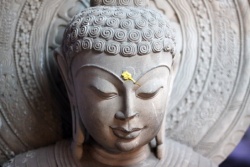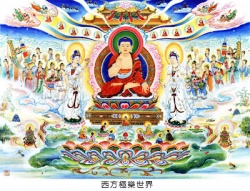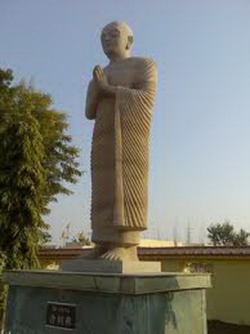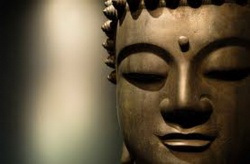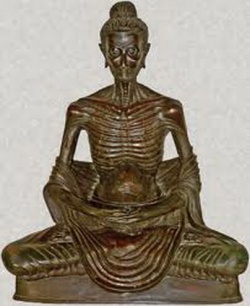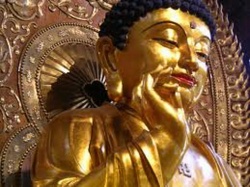Difference between revisions of "How the Eight Consciousnesses Cause Delusion"
m (Text replacement - "waking" to "waking") |
|||
| Line 50: | Line 50: | ||
How is this possible? The answer lies in the fact that since [[beginningless]] time we have been perceiving sights, {{Wiki|sounds}}, {{Wiki|smells}}, {{Wiki|tastes}}, and [[bodily]] [[sensations]] and these [[perceptions]] have been creating imprints or latencies in the ground [[consciousness]]. Habituation of having [[experienced]] a certain [[visual]] [[form]] will create a [[latency]] for that very [[form]]. Eventually, that [[latency]] will [[manifest]] from the ground [[consciousness]] as a [[visual]] [[form]] again, but it will be [[perceived]] as external to ourselves. | How is this possible? The answer lies in the fact that since [[beginningless]] time we have been perceiving sights, {{Wiki|sounds}}, {{Wiki|smells}}, {{Wiki|tastes}}, and [[bodily]] [[sensations]] and these [[perceptions]] have been creating imprints or latencies in the ground [[consciousness]]. Habituation of having [[experienced]] a certain [[visual]] [[form]] will create a [[latency]] for that very [[form]]. Eventually, that [[latency]] will [[manifest]] from the ground [[consciousness]] as a [[visual]] [[form]] again, but it will be [[perceived]] as external to ourselves. | ||
| − | Everything the [[mind]] [[thinks]] occurs within the [[mind]] itself. As mentioned before, the closest analogy of this process is a [[dream]]. Although [[dream]] [[phenomena]] have no connection to external [[objects]], we become [[attached]] to their [[mental]] images which are, in fact, these imprints of latencies coming from the [[eighth consciousness]]. Because we think that [[dream]] [[phenomena]] and external [[objects]] are the same, we [[grasp]] at that [[thought]]. Apart from the [[grasping]], there is no connection between [[phenomena]] [[experienced]] in [[mental]] [[consciousness]] and external [[objects]]. This is why it is said everything appearing to the [[five senses]] arises, in fact, only from [[mind]]. | + | Everything the [[mind]] [[thinks]] occurs within the [[mind]] itself. As mentioned before, the closest analogy of this process is a [[dream]]. Although [[dream]] [[phenomena]] have no [[connection]] to external [[objects]], we become [[attached]] to their [[mental]] images which are, in fact, these imprints of latencies coming from the [[eighth consciousness]]. Because we think that [[dream]] [[phenomena]] and external [[objects]] are the same, we [[grasp]] at that [[thought]]. Apart from the [[grasping]], there is no [[connection]] between [[phenomena]] [[experienced]] in [[mental]] [[consciousness]] and external [[objects]]. This is why it is said everything appearing to the [[five senses]] arises, in fact, only from [[mind]]. |
[[File:1018744.jpg|thumb|250px|]] | [[File:1018744.jpg|thumb|250px|]] | ||
===3. A brief introduction to the sixth and [[seventh consciousnesses]]=== | ===3. A brief introduction to the sixth and [[seventh consciousnesses]]=== | ||
| Line 58: | Line 58: | ||
its particular [[characteristics]] are known by the [[mental]] event of identification, which is [[dependent upon]] the [[mental]] [[consciousness]]: The immediate [[mentality]] and the afflicted-[[mentality]]. | its particular [[characteristics]] are known by the [[mental]] event of identification, which is [[dependent upon]] the [[mental]] [[consciousness]]: The immediate [[mentality]] and the afflicted-[[mentality]]. | ||
| − | Briefly, we'll explain the [[Chittamatra]] or [[Mind-only school]] associated with [[Asanga]] and the [[Madhyamaka]] or [[Middle-way]] school associated with [[Nagarjuna]]. The [[Chittamatrins]] [[state]] that all [[phenomena]] are [[mind]]; the [[Madhyamakas]] [[state]] that all [[phenomena]] are [[empty]]. This text presents the [[information]] in terms of experiential [[Mahamudra]] [[meditation]] (in contrast to the methods of analytical [[meditation]]) by first [[teaching]] that all [[phenomena]] are the [[mind]], and then describing the [[empty nature]] of the [[mind]]. | + | Briefly, we'll explain the [[Chittamatra]] or [[Mind-only school]] associated with [[Asanga]] and the [[Madhyamaka]] or [[Middle-way]] school associated with [[Nagarjuna]]. The [[Chittamatrins]] [[state]] that all [[phenomena]] are [[mind]]; the [[Madhyamakas]] [[state]] that all [[phenomena]] are [[empty]]. This text presents the [[information]] in terms of experiential [[Mahamudra]] [[meditation]] (in contrast to the [[methods]] of analytical [[meditation]]) by first [[teaching]] that all [[phenomena]] are the [[mind]], and then describing the [[empty nature]] of the [[mind]]. |
It is easier to first [[recognize]] that the [[nature]] of all [[phenomena]] is the [[mind]]; having gained that direct {{Wiki|recognition}}, we realize that [[mind]] itself is [[empty]]. Presenting the [[subject]] in this order facilitates direct {{Wiki|recognition}}, whereas simply {{Wiki|learning}} the [[Madhyamaka]] [[view]] that [[phenomena]] are [[empty]] makes it difficult to gain [[understanding]]. Thus [[Rangjung Dorje]] first teaches that all [[phenomena]] are the [[mind]], and then teaches how the [[mind]] itself is birthless. | It is easier to first [[recognize]] that the [[nature]] of all [[phenomena]] is the [[mind]]; having gained that direct {{Wiki|recognition}}, we realize that [[mind]] itself is [[empty]]. Presenting the [[subject]] in this order facilitates direct {{Wiki|recognition}}, whereas simply {{Wiki|learning}} the [[Madhyamaka]] [[view]] that [[phenomena]] are [[empty]] makes it difficult to gain [[understanding]]. Thus [[Rangjung Dorje]] first teaches that all [[phenomena]] are the [[mind]], and then teaches how the [[mind]] itself is birthless. | ||
Latest revision as of 22:49, 23 November 2020
by Most Venerable Khenchen Thrangu Rinpoche
The Treatise "Distinguishing Consciousness from Wisdom" presents an outline of the whole treatise in a brief form in the first eleven verses.
We have reached the point in the treatise where each of these points is covered in more detail.
1. The Summary of the Eight Consciousnesses
The causes, conditions, and interdependence...
have been taught by the Buddha to be the six consciousnesses,
The afflicted mental consciousness, and the ground consciousness. Causes, conditions, and interdependence is necessary for things to arise in the mind; they don't appear without reason.
For example, growing a flower requires a seed, the necessary conditions of water, sunlight, and soil.
Finally, interdependence is necessary; the cause and conditions must be in the right amount, and occur at the right time.
If a flower has too much water or not enough sunlight, it will not grow.
Likewise, birth in samsara doesn't just happen; its causes and conditions and their interdependence must be present for all the illusionary appearances of samsara to arise.
The six consciousnesses are literally called the six accumulations, and resemble the teaching of the five skandhas. The six consciousnesses are not a single entity, are impermanent, and do not possess inherent reality; they are instead an accumulation of many moments of consciousness. As an example of their impermanence, we assume that we have a single visual consciousness from morning to evening. Upon close examination, however, we discover that a visual consciousness only arises when a sensory object contacts the sensory organ. When this circumstance doesn't occur, the visual consciousness ceases. When we see a red color, a visual consciousness perceiving red arises and ceases. A visual consciousness arises for an instant and then ceases, allowing the next visual consciousness to arise and cease in the next instant. This process also applies to the other consciousnesses-an auditory consciousness perceives a loud sound and then a quiet sound, and so on, with consciousnesses continually arising and ceasing in a succession of instants.
The samsaric appearances that arise from these causes and conditions are of two kinds: common and individual. Some appearances are the result of identical causes created by many beings, so that something will be seen by everyone in common, such as everyone in a particular room seeing that it has two pillars. However, there are certain individual causes and conditions which result in beings having their own individual experiences of happiness and discomfort. For example, some people taste chili and think it's delicious, while others taste it and experience discomfort. Even though the flavor and the sensory organs of their tongues is the same, differing individual experiences occur. These different perceptions are due to different latencies that have been laid down in the ground consciousness.
2. The Source of the Six Consciousnesses
Both faculties and objects arise from the mind.
This manifestation of sensory objects and faculties Is dependent upon an element that has been present throughout beginningless time. The five non-cognitive sensory consciousnesses perceive objects vividly because they do not discriminate between beautiful and ugly, desirable and undesirable, and so on. Nagarjuna compared these senses to an idiot who can see everything clearly, but cannot think, "this is good and that is bad." In contrast the sixth mental consciousness cannot directly perceive objects; it rather follows what is perceived by the sensory consciousnesses, and has only a rough or vague idea of external forms. It is conceptual and conceives of phenomena as being, good or bad, similar or different, and so on.
Having established that there are sensory objects and sensory faculties, we may now ask, "Where did these external phenomena come from?" The answer is that all of external phenomena-houses, mountains, roads, and their perceptions-originated from the mind. They all arose out of the ground consciousness.
How is this possible? The answer lies in the fact that since beginningless time we have been perceiving sights, sounds, smells, tastes, and bodily sensations and these perceptions have been creating imprints or latencies in the ground consciousness. Habituation of having experienced a certain visual form will create a latency for that very form. Eventually, that latency will manifest from the ground consciousness as a visual form again, but it will be perceived as external to ourselves.
Everything the mind thinks occurs within the mind itself. As mentioned before, the closest analogy of this process is a dream. Although dream phenomena have no connection to external objects, we become attached to their mental images which are, in fact, these imprints of latencies coming from the eighth consciousness. Because we think that dream phenomena and external objects are the same, we grasp at that thought. Apart from the grasping, there is no connection between phenomena experienced in mental consciousness and external objects. This is why it is said everything appearing to the five senses arises, in fact, only from mind.
3. A brief introduction to the sixth and seventh consciousnesses
Though a sensory consciousness perceives an object,...
its particular characteristics are known by the mental event of identification, which is dependent upon the mental consciousness: The immediate mentality and the afflicted-mentality.
Briefly, we'll explain the Chittamatra or Mind-only school associated with Asanga and the Madhyamaka or Middle-way school associated with Nagarjuna. The Chittamatrins state that all phenomena are mind; the Madhyamakas state that all phenomena are empty. This text presents the information in terms of experiential Mahamudra meditation (in contrast to the methods of analytical meditation) by first teaching that all phenomena are the mind, and then describing the empty nature of the mind.
It is easier to first recognize that the nature of all phenomena is the mind; having gained that direct recognition, we realize that mind itself is empty. Presenting the subject in this order facilitates direct recognition, whereas simply learning the Madhyamaka view that phenomena are empty makes it difficult to gain understanding. Thus Rangjung Dorje first teaches that all phenomena are the mind, and then teaches how the mind itself is birthless.
The sixth mental consciousness has no form and is called "the intermediate consciousness" or the consciousness following immediately upon arising or immediately upon cessation. As soon as a sensory perception of form occurs, the mental conception of that form immediately arises. The other senses also have a mental conception immediately following perception. The sixth mental consciousness like the sensory consciousnesses, also exists in one instant and ceases in the next; mental consciousness that has ceased becomes the condition for the mental consciousness following in the next instant.
This verse introduces how the other consciousnesses fit in with the sensory consciousness in the process of perception. Even though the sensory consciousnesses perceive external sense objects, they are not recognized or perceived as a solid external object until this perceptual process reaches the mental consciousness and the object is identified. The mental consciousness, however, does not store a memory of all the objects-this comes from the seventh and eighth consciousness. The seventh consciousness is particularly mentioned and it has two aspects or functions: it serves as the immediate mentality which ensures for the continuity of the mind and it also is responsible for the afflicted mentality which is responsible for generating the disturbing emotions.
4. The Immediate Aspect of the seventh Consciousness
The first of those is immediate because...
it is the condition for the arising and ceasing of the six consciousnesses. It occurs in the same numbers as those of the momentary arising and ceasing of the six consciousnesses. It can be known by a mind that is yoga-endowed and through the teachings of the Victorious One. The third condition of the four conditions needed for perception to occur is called the immediate condition. When we consider both the afflicted and the immediate aspect of the seventh consciousness, we must know that they are always present within the six consciousnesses.
The instant a visual object is seen, for example, the visual consciousness ceases, allowing the next instant of consciousness to arise. This sequence applies to all six consciousnesses. The immediate mind is the condition for the immediate arising and cessation of the six consciousnesses; when a consciousness ceases, it does not disappear, instead it subsides into the ground consciousness. The immediate mentality is the condition for all appearances to arise from any of the consciousnesses and to settle into the ground consciousness.
How does the immediate mentality cause instants of the mind to arise?
An instant of mind cannot arise if there isn't a preceding instant of mind that ceases. There has to be a continuum of instants that immediately follow the preceding instants. When one instant of mind ceases, a latency in the ground consciousness immediately manifests as the next instant of mind. This power of immediacy never ceases. It is continually present, so that the continuity of the mind is never interrupted.
How can we know this to be true? This can be seen by the "yoga-endowed." The word yoga is Sanskrit for "union" and in this context refers to the union of tranquility and insight meditation. By directly seeing our mind with Shamatha and Vipashyana meditation, we can see the immediate mind. We see how the arising of the six consciousness themselves is also a precondition for the arising of the six consciousness, because of the immediate consciousness, an instant of consciousness settles into the ground consciousness as soon as it ceases. The other method of gaining this knowledge is by understanding the Victorious One's (the Buddha's) teachings. We are able to understand that the immediate mind arises on account of there being a condition for the six consciousnesses, and that it is also a condition for their arising. It has been explained how all phenomena arise from the mind and how the mind itself is empty.
With everything in samsara and nirvana appearing from the mind, we discover that the mind itself manifests as the eight consciousnesses. We all experience phenomena differently, for example, two people can go to the same movie and one will love it and the other will hate it. Also beings in the six different realms experience phenomena differently. Hungry ghosts, for example, will perceive all kinds of desirable things and also perceive that they can't obtain them. All experiences whether happiness or suffering, are due to particular causes and conditions. The basic cause of these experiences is the eighth ground consciousness, the alaya consciousness. We can begin to understand the function of the ground consciousness through our daily experience. We have a basic clarity of the mind which is an awareness or a continuous knowing. When we look, hear, think, and so on there is always a continuity of the mind; a knowing that accompanies us from birth until death; with the continuum of this clarity present until we achieve Buddhahood. Every action we take creates a latent karmic imprint and these tendencies automatically flow into the ground consciousness where they are stored. These karmic imprints do not, however, remain stored because they manifest sooner or later. These become our experience of samsara.
5. The Afflicted Aspect of the Seventh Consciousness
The second is an aspect of this immediate mentality.
It is called the afflicted-mentality because It believes the mind as self, possesses pride, has attachment to the self, and has ignorance, and gives rise to all the destructive views. After the six consciousnesses are described, the text commences explaining the seventh consciousness. This consciousness is afflicted and immediate. The seventh consciousness is the ever-present feeling of "I" or "self," the basis of ego. Because the mind is bound by this consciousness, it is called afflicted. The feeling of "I" is present in one instant and when that instant ceases, it is present in the next instant. That is why it is called the immediate consciousness. There is never a discontinuity in the mental continuum; as long as there is a mind, there is a continuous succession of instants immediately proceeding each other. We cannot say that this succession of instants stops even after a hundred years. There is the continuous succession of instants of consciousness and this is called the immediate consciousness.
The seventh (afflicted) consciousness is also present in all beings as a very subtle clinging to a self, which is often explained in terms of mind and mental events. Mind and mental events refer to the clarity and awareness of the mind which sees the nature of things. Mind is the basic awareness and includes all the consciousnesses. When the mind changes, a mental event arises. There are fifty-one mental events listed in the Abhidharma. A mental event denotes that the mind has undergone a change-aspiration gradually becomes samadhi, which are positive, and feelings of resentment may become deceit, which are negative.
The afflicted mind is described in terms of four mental events:
- clinging to a self by thinking there is a "me" and "I"
- pride which is believing the "I" is superior;
- attachment to the self which is believing oneself more deserving than others;
- ignorance which accompanies the above three and is ignoring how things truly are (i.e., the egolessness of self). We may wonder whether the afflicted mind is good or bad.
Generally, there are three types of actions or karma:
- good action or karma, done with the motivation to help others,
- bad action or karma, done with the motivation to harm others,
- neutral action such as walking, eating, or sitting which has neither a good or bad motivation.
There are two kinds of neutral actions: those that do not obscure liberation, and those that do. Walking somewhere does not cause obscurations or prevent liberation, whereas clinging to a self does prevent liberation, and so is an obstacle. Yet it is in itself not good or bad, because, if we think something like, "Oh, I must do good actions and need to accumulate merit" subsequent actions are good, or conversely, "Oh, I have to do something bad" the subsequent action becomes negative.
Rangjung Dorje presents a fairly unique view of the seventh consciousness. Generally, what was taught by Buddha in the Mahayana that discusses emptiness are called the sutras and the Buddha's instructions on meditational deities and Vajrayana practice are called the tantras. The teachings given by the Buddha were translated into Tibetan and placed in a collection called the Kangyur.
There are two sections to the Kangyur: one dealing with the sutras and one dealing with the tantras. The Third Karmapa used both the sutras and the tantras for this text. His description of how the eighth consciousness stores karmic imprints is clarified in a tantra called The Tantra of the Vajra's Point which deals with how the mind perceives external phenomena. In the sutras of the Kangyur the Chittamatrins, in their teaching on the eight consciousnesses, taught the seventh consciousness was only an afflicted consciousness underlying a continuous belief in a self, but was not involved in the immediate condition.
Rangjung Dorje's own special view, however, combines this sutra and tantra view and adds the Madhyamaka view to the Chittamatra view, so that the seventh consciousness here is taught to have the aspect of immediate mentality as well as afflicted mentality.
6. Characteristics of the Immediate and Afflicted Mentalities
The immediate mentality, which is instantaneous...
upon the cessation of the six consciousnesses, is the location for the arising of those consciousnesses.
The afflicted mentality is the location for the afflictions. Therefore, mentality has two aspects Due to their power to create, and its power to obscure. Another way to look at mind is to consider it as a succession of instants rather than a single entity. The moment an instant of consciousness arises, it ceases, allowing the next instant of consciousness to arise. Within this progressive succession of instants, external objects are perceived. We may think that the presence of an external object causes sensory consciousnesses to arise, and therefore that an external object is the causal condition, and that the sensory consciousnesses are its effect. However, if an object were the cause, and the consciousness were its result, then what would happen when the instant passed? If we perceive the effect, then the cause must have ceased, thus the object would have ceased. If a consciousness were the result in the following instant of consciousness, and its cause had existed in the previous instant, then the consciousness (the effect) would not be present when the object is present (the cause). They would not be connected and, therefore, have no relationship; thus, one cannot be the cause and the other the effect. We may claim that they exist at the same time, in a cause and effect relationship. Yet if they existed simultaneously, there would be no need for a cause, because its effect would already be present. Therefore, it is not logical to claim that an external object is the cause for a sensory consciousness of that object.
Non-Buddhist and Hinayana Buddhists say that the mind and external objects are different. However, if we carefully analyze the situation, we discover that external objects and inner mind are one. External objects actually arise from the mind, just like a dream. In a dream we see forms, but there are no forms that exist outside of our mind. In a dream we see, hear, smell, taste, and feel bodily sensations, but there are no sounds, smells, tastes, or sensations existing outside our mind. Yet they do have appearance; an unreal appearance. Similarly, while waking, everything we see is an appearance, and arises from our mind.
Finally, Rangjung Dorje summarizes the two main functions of the afflicted consciousness. The afflicted consciousness is the source or "location" for the arising negative emotions or afflictions. This continuously present belief in a self gives rise to desire, anger, ignorance, envy, pride, and so on. This verse then concludes that the seventh consciousness has two aspects: the power to create the six consciousnesses (the immediate aspect) and the power to obscure (the afflicted aspect) which prevents the attainment of liberation.
7. The Ground Consciousness
To those with superior understanding,...
the Buddha taught the 'ground consciousness.' It was also named the 'foundation consciousnesses.'
The 'location consciousness,' and the 'acquiring consciousness.' All the actions created by the other seven consciousnesses Are accumulated, distinctly and impartially within it, like rain and rivers flowing into the ocean. Therefore it is also named the 'ripening consciousness.'
The first two levels of this verse is a brief explanation of the eighth (ground) consciousness and the rest of the lines are the detailed description of this consciousness. The fourth of the four conditions for perception to occur is the causal condition, or the ground consciousness. The ground or alaya consciousness was not mentioned in the Theravada texts which describe only the first six consciousnesses. The seventh and eighth consciousnesses were not taught in the Buddha's early teachings. Because it could have incorrectly been taken for being permanent and therefore the same as the belief in a permanent self (Skt. atman).
However, the ground consciousness is not a permanent self because its nature is emptiness. It is the source of all samsaric appearances. A self is considered basic and we have great attachment to it, but this isn't true for the ground consciousness. In the Abhidharma teachings, however, the Buddha said, "I have explained the ground consciousness to those who are pure," meaning that the ground consciousness was introduced to Mahayana bodhisattvas or "those with superior understanding" in this verse.
The ground consciousness has many functions so Rangjung Dorje explains these by giving each of them names. These are called the "basis consciousness" because the eighth consciousness is the basis for the mind; the "location consciousness" because it is the location of the mind, and the "acquisition consciousness" because it acquires all the karmic latencies that are laid down.
The reason the Buddha taught the subject of the ground consciousness at all is that when karma accumulates, the latent karmic imprints settle in the ground consciousness to express themselves at a later time. A karmic latency will awaken as experiences of suffering or happiness. Positive karma doesn't immediately express itself as happiness; so doing many positive deeds will not result in a rebirth in a paradise. Rather the karmic latencies rest within the ground consciousness and arise later as a result, for example, the joy of being reborn in a slightly more favorable situation. Similarly, accumulated negative karma does not express itself immediately as rebirth in the hell realms, but the karmic imprints remain in the ground consciousness to ripen under the appropriate circumstances causing suffering later on. Thus the ground consciousness can be said to be the "ripening consciousness."
The negative and the positive qualities increase due to habituation. For example, a person becomes angry again and again and then becomes habituated to anger, causing the latency of anger to increase in the mind. The same is true with desire. When one desires something again and again, the latencies of desire increase. This process also occurs for the positive qualities: a person may not have much love, compassion, or wisdom, but by engaging in love, compassion, or study; the imprints of these positive qualities increase in the ground consciousness. If there were only six consciousnesses, then thoughts would arise and cease without anything left to increase or develop such as the good qualities to reach Buddhahood. The increase of these positive qualities occurs only because positive tendencies are planted in the ground consciousness. The ground consciousness is the foundation and location for the mind because all karmic latencies are stored in the ground consciousness.
A momentary visual consciousness instantly ceases (when the next instant appears) and does not occur again; instead a new momentary visual consciousness appears.
Similarly, a mental consciousness is created and ceases instantly; sometimes a mental consciousness does not appear at all. However, the latencies for the arising of these consciousnesses are contained within the ground consciousness.
Thus, we can remember a visual perception that occurred in the past; and remembering it, strengthens the latency.
The ground consciousness is very important for our practice of the dharma.
If we do not maintain mindfulness and awareness, our disturbing emotions gradually increase, from day to day, from lifetime to lifetime.
However, if we develop mindfulness and awareness, our mind will gradually improve due to the latencies being established in the ground consciousness.
For example, when we begin to practice, there may not be much love and compassion in our meditation.
But if we persist and meditate on love and compassion, through the gradual accumulation of the latencies of love and compassion in the ground consciousness, we will gradually progress to a point where our meditation will have vast love and compassion.
In terms of dharma practice, the ground consciousness is very important, because through meditation our mind overcomes negativity and develops positive imprints.
Habituating ourselves to positive thoughts and actions allows negative imprints to decrease and positive qualities to increase. Meditation is very similar to habituation.
By developing samadhi, negative tendencies can be transformed into positive imprints, which can be developed until Buddhahood is attained. We can witness the effect of latencies in our daily life. Some children are very intelligent and some are not.
This is due to the presence or absence of latencies to study in previous lifetimes. Some children are naturally very kind due to positive latencies laid down in their ground consciousnesses in previous lifetimes, and some children are very aggressive, due to negative latencies.
We can also see an aggressive child who has bad behavior gradually change as he grows older; through his cultivation of mindfulness and awareness, he can slowly with the right training establish new latencies by developing love, compassion, and humility as an adult.
Conversely some good children grow up to be bad due to the negative latencies they establish during their childhood.
The eighth consciousness is also the foundation of experience.
Should someone be born into a higher existence of a god, jealous god, or human being his or her experiences of happiness would be based upon the ground consciousness,
and should someone fall into the lower realms, his or her experiences would also be based on the ground consciousness.
Thus the eighth consciousness is the basis of all experiences within samsara,
Creating imprints in the present leads to experiencing their results in the future;
like a child who goes to school and studies hard-that activity will create an imprint in the child's mind that will allow him or her to become a teacher later on.
If there were no learning, there would be no imprint, and no possibility of being a teacher in the future.
This is how the eighth consciousness functions and why it is responsible for the various existences in samsara, and why it is also called the consciousness of acquisition.
The five sensory and the sixth mental consciousness are either positive, negative, or neutral.
The seventh (afflicted) consciousness is neutral but has two possibilities:
it may be ignorant and therefore the basis of the disturbing emotions, and may be obscuring because it obscures liberation.
The eighth (ground) consciousness is also neutral; however, it is not obscuring like the afflicted consciousness, it instead has an aspect of clarity.
This clarity allows all phenomena (places, bodies, existences, and so forth) to manifest, but does not obscure liberation.
The other seven consciousnesses create positive and negative imprints in the eighth consciousness.
A simile to how this occurs is given in the text: when it rains, the water naturally flows into the rivers, and the rivers,
whether they are dirty or clean, naturally flow into the ocean.
Similarly, positive and negative imprints naturally flow into the ground consciousness.
As it creates everything, and is the ground from which all seeds sprout, it is described as 'the causal condition.'
However, because it is eliminated When the seven consciousnesses are negated.
It is also called the 'conditional consciousness.' All the karmic seeds, good or bad, within the ground consciousness,
sprout and manifest as the other seven consciousnesses, as if the ground consciousness were the ocean and the other seven consciousnesses were waves that appear upon its surface.
The ground consciousness is responsible for all illusory appearances, but is not the basis of Buddhahood, which is freedom from delusion.
This is why the eighth consciousness is a consciousness and not a wisdom.
This concludes the section of the treatise that deals with the impure states of mind, the consciousnesses.
The ground consciousness is the source of all delusory experiences.
It is not the basis of Buddhahood because Buddhahood is freedom from delusion. The nature of the ground consciousness is delusion;
it is not in harmony with the true nature of reality. When Buddhahood or arhatship is attained, the ground consciousness is transformed.
When the ground consciousness ceases, all the consciousnesses are transformed into ultimate wisdom.
To summarize there are impure consciousnesses and pure wisdoms.
In defining the impure consciousnesses it has been taught that the root of samsara and nirvana is the mind and that the mind itself is birthless.
